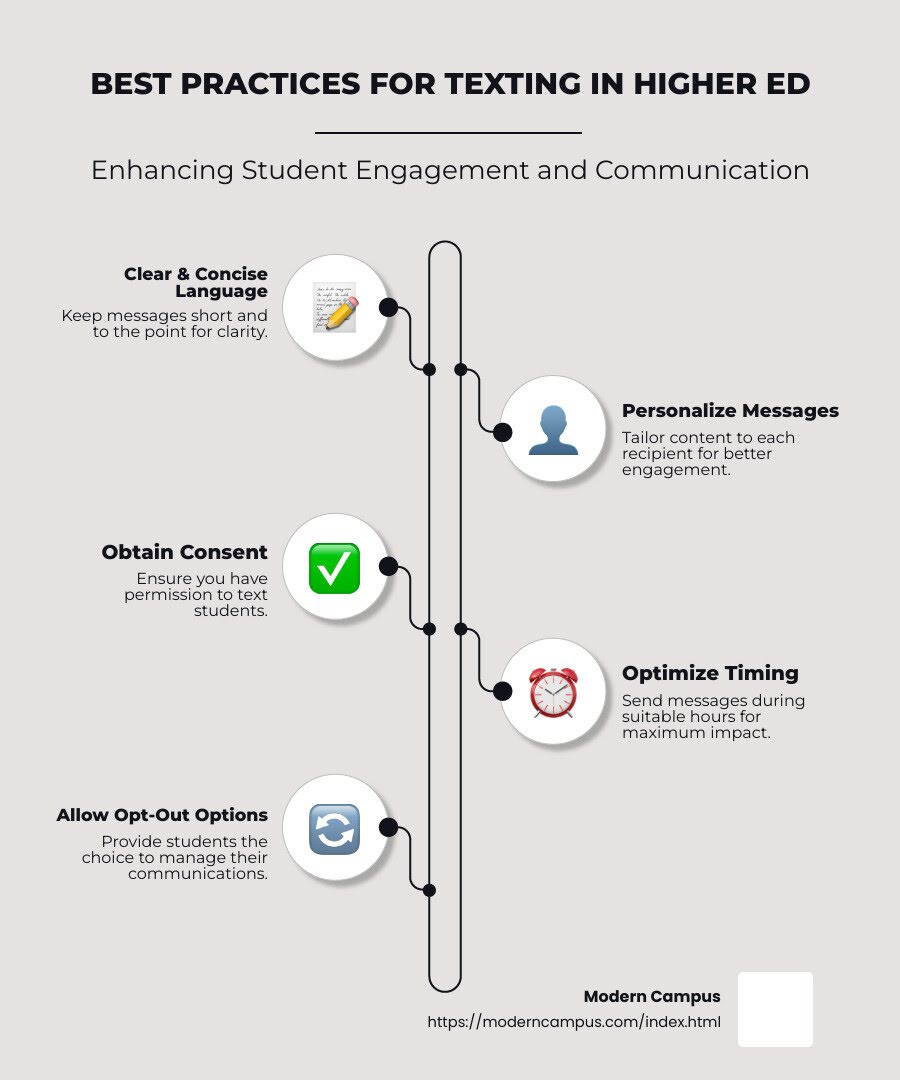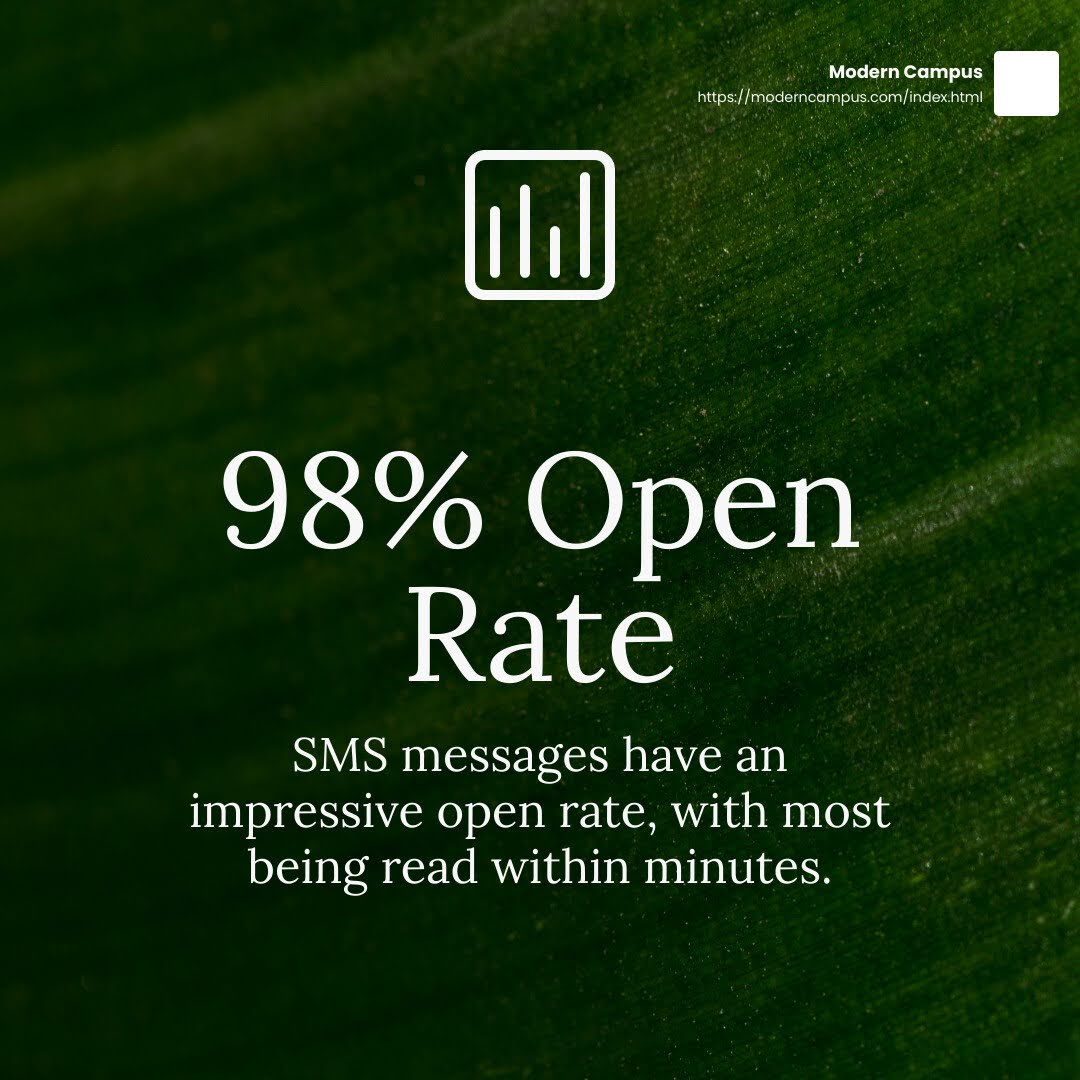Best Practices for Texting in Higher Education
Text messaging is reshaping communication in higher education by improving student engagement and operational efficiency. With a 98% open rate, SMS messages are far more effective than emails or flyers for getting important information across. When used wisely, text messaging can transform how institutions interact with students, alumni and staff.
Following best practices for texting in higher education enhances student engagement and communication. Texting offers a direct and effective way to connect with students, ensuring important information isn't missed. Here are some key points:
- Use Clear and Concise Language: Keep messages short and to the point.
- Personalize Messages: Tailor content to the receiver for better engagement.
- Obtain Consent: Always ask for permission to text students.
- Optimize Timing: Send messages during appropriate hours to increase readability.
- Allow Opt-Out Options: Give students control over their communications.
If you’re looking to streamline this communication process at your campus, these best practices are your roadmap to success.

Importance of Text Messaging in Higher Education
Text messaging has become a must-have in higher education, offering a powerful tool for communication strategy and student engagement. When emails often go unread and bulletin boards are overlooked, texting provides a direct line to students. With this, students receive crucial information quickly and efficiently.
Direct Communication
Text messaging allows institutions to reach students directly and immediately. With messages read within minutes, SMS is an incredibly effective way to ensure that important updates are seen. Unlike emails that might get lost in crowded inboxes, texts cut through the noise and deliver information straight to students' hands.
Students are more likely to read and respond to text messages than emails or other forms of communication, making SMS an essential tool for immediate engagement. Whether it’s reminders about registration deadlines, class cancellations or financial aid updates, text messaging ensures critical information reaches students quickly, helping them stay informed and take necessary actions in real time.
Fostering Connections
Text messaging also supports higher education institutions in fostering a more personalized and connected learning environment. By tailoring messages to individual student needs, such as sending course recommendations or academic alerts, institutions can help students stay on track, improve retention and enhance overall academic performance.
Additionally, SMS's simplicity and convenience allow students to engage with their institution without the hassle of navigating more complex communication platforms, making it a key tool in creating a streamlined, student-centric experience.
Text messaging improves student engagement, enhances communication efficiency and ensures that students have the information they need to succeed, all while catering to the mobile-first preferences of today’s learners.

Enhancing Student Engagement
Engagement is key to student success and text messaging plays a vital role in keeping students connected to their campus community. Whether it's reminders about application deadlines, notifications of upcoming events or alerts about class changes, texts keep students informed and engaged. This constant communication helps students feel more connected to their institution, which can improve retention rates and academic success.
Building a Robust Communication Strategy
Incorporating text messaging into a broader communication strategy allows institutions to reach students where they are most active—on their phones. By aligning texting with other communication channels like emails and social media, colleges can create a cohesive strategy that maximizes reach and impact. This multi-channel approach ensures that no student is left out, enhancing the overall effectiveness of communication efforts.
Text messaging is a crucial component of a modern communication strategy that can significantly improve student engagement and success. By leveraging the immediacy and personal nature of texting, institutions can foster a more connected and engaged student body.
Designing Effective Text Messages for Higher Education
Creating effective text messages in higher education involves a delicate balance of brevity, clarity and personalization. Text messaging campaigns should be designed with the student's experience in mind.
- Message Length: Keep it short and sweet. Aim for messages that are concise yet informative. This ensures students can quickly grasp the message without feeling overwhelmed.
- Tone: Maintain a casual yet professional tone. This helps in creating a connection without losing professionalism. Ending with a question can encourage engagement when a response is desired.
- Emojis: Use emojis sparingly and only if they align with the institution's brand. Limit to one emoji per message to maintain clarity and professionalism.
Timing and Frequency
When it comes to timing and frequency, consider the student's schedule and availability.
- Deployment: Schedule messages to align with the ideal time of day for the targeted cohort. Avoid sending texts during very late-night or early-morning hours unless the situation is urgent.
- Response Time: Allow adequate time for students to respond or take action. This ensures that the message is received and acted upon promptly.
- Message Limits: Be mindful of the number of messages sent. Too many messages can lead to students opting out, so ensure each text is meaningful and necessary.
Compliance and Consent
Adhering to compliance regulations is a must for any institution using text messaging.
- A2P Campaign: Ensure that your texting falls under the Application-to-Person (A2P) Campaign guidelines, which are designed for promotional or informational purposes.
- Opt-in: Always obtain consent before sending messages. A simple opt-in question, like "Would you like to receive SMS messaging from us?" can be added to forms capturing student information.
- TCPA Compliance: Follow the Telephone Consumer Protection Act (TCPA) guidelines. This includes maintaining proper consent documentation and providing clear instructions for opting out, such as "Reply STOP to unsubscribe."
By following these best practices, higher education institutions can create effective and compliant text messaging strategies that improve student engagement and communication.
Text Messaging Strategies for Different Audiences
Engaging Prospective Students
Text messaging is a powerful tool for engaging prospective students. Application status updates via SMS can ease anxiety and keep applicants informed. A simple, "Your application is under review. Expect an update soon!" can make a big difference.
Campus visits are another crucial touchpoint. Sending reminders like, "Looking forward to seeing you at the campus tour tomorrow at 10 AM!" ensures high attendance. It also gives students the chance to ask last-minute questions.
When it comes to financial aid, timely reminders about deadlines and document submissions can prevent missed opportunities. A well-timed message such as, "Don't forget to submit your financial aid documents by Friday!" helps students stay on track.
Accommodating Non-Traditional Students
When designing text messaging strategies for non-traditional students, focus on personalization and relevance. Non-traditional students, such as working professionals, parents and part-time learners often have different priorities and schedules compared to traditional students. Personalizing messages based on the student’s program, academic journey or personal circumstances ensures the communication is meaningful.
Timeliness and clarity are also critical in communicating with non-traditional students. These students are likely managing multiple responsibilities, making it essential to send concise and actionable messages. Texts should provide immediate value and offer straightforward calls to action.
Respecting non-traditional students’ time is another best practice. Avoid texting during working hours, late at night or on weekends unless the information is urgent or time-sensitive. Institutions can implement scheduling tools to ensure that messages are delivered at optimal times, increasing the likelihood of them being read and acted upon.
Automated texts can be triggered by specific actions or milestones, such as a missed deadline, upcoming class registration, or a low account balance. This way, institutions can ensure students receive timely reminders without manual intervention. Automation also ensures consistency and accuracy, as students receive relevant information based on their personal situation or academic timeline.
Supporting Current Students
For current students, text messaging can support their academic journey. Sending academic success tips or reminders about tutoring sessions can boost their performance. A message like, "Struggling with calculus? Join our tutoring session this Thursday!" can provide much-needed support.
Event reminders are essential for keeping students engaged with campus life. Whether it's a club meeting or a guest lecture, a quick reminder can increase participation: "Join us for the Career Fair tomorrow in the main hall at 1 PM!"
Text messaging is also effective for career services. Notify students about job fairs or internship opportunities with messages like, "Internship applications are open! Check your email for more details."
Connecting with Alumni
Alumni engagement is vital for building a strong institutional network. Texting can play a key role in donor recognition by sending personalized thank-you messages. A simple "Thank you for your generous support!" can strengthen alumni ties.
Alumni events are perfect occasions to leverage SMS. Remind alumni about upcoming gatherings with messages like, "Don't miss the Alumni Reunion this Saturday at 6 PM!"
Finally, create engagement opportunities by inviting alumni to participate in mentorship programs or guest lectures. A message such as, "Share your experience with current students at our upcoming mentorship event!" can foster valuable connections.
By tailoring text messaging strategies to these different audiences, higher education institutions can improve engagement and communication across the board.
How Software Solutions Enhance Your Texting Strategy
Software solutions designed for higher education enhance text messaging strategies by streamlining and automating communication processes, ensuring timely and personalized engagement with students. These platforms allow institutions to schedule and send automated messages for important reminders–such as registration deadlines, financial aid updates and event notifications–reducing the manual workload for staff.
These tools can segment student populations and allow for targeted messaging, ensuring that the right students receive relevant information. Automation further improves efficiency by sending real-time alerts based on student actions–such as course registration or missed deadlines–fostering a more connected and responsive communication flow.
Adopting higher education software solutions leads to higher engagement, better student retention and a smoother overall experience for both students and staff.
Execute the Best Texting Strategy With Comprehensive Software Solutions for Higher Ed
Text messaging is a vital tool in students' educational journeys. By implementing the best practices for texting in higher education, institutions can foster meaningful connections with students, from the moment they express interest in a program to the day they become proud alumni. Whether it's through timely reminders, personalized messages or strategic nudges, texting helps keep students informed and engaged.
Modern Campus provides a suite of products to support this mission, including our SMS solution, Modern Campus Message. This tool ensures that your communications are effective and compliant with important regulations like the TCPA. With features like opt-in processes and consent documentation, we help institutions maintain trust and transparency with their students.
Let Modern Campus be your guide in this digital era of education. Book a demo to create a seamless and enriching experience for every student.
Last updated: December 16, 2024

